AUDI RS7 SPORTBACK 2015 Owners Manual
Manufacturer: AUDI, Model Year: 2015, Model line: RS7 SPORTBACK, Model: AUDI RS7 SPORTBACK 2015Pages: 302, PDF Size: 74.76 MB
Page 171 of 302
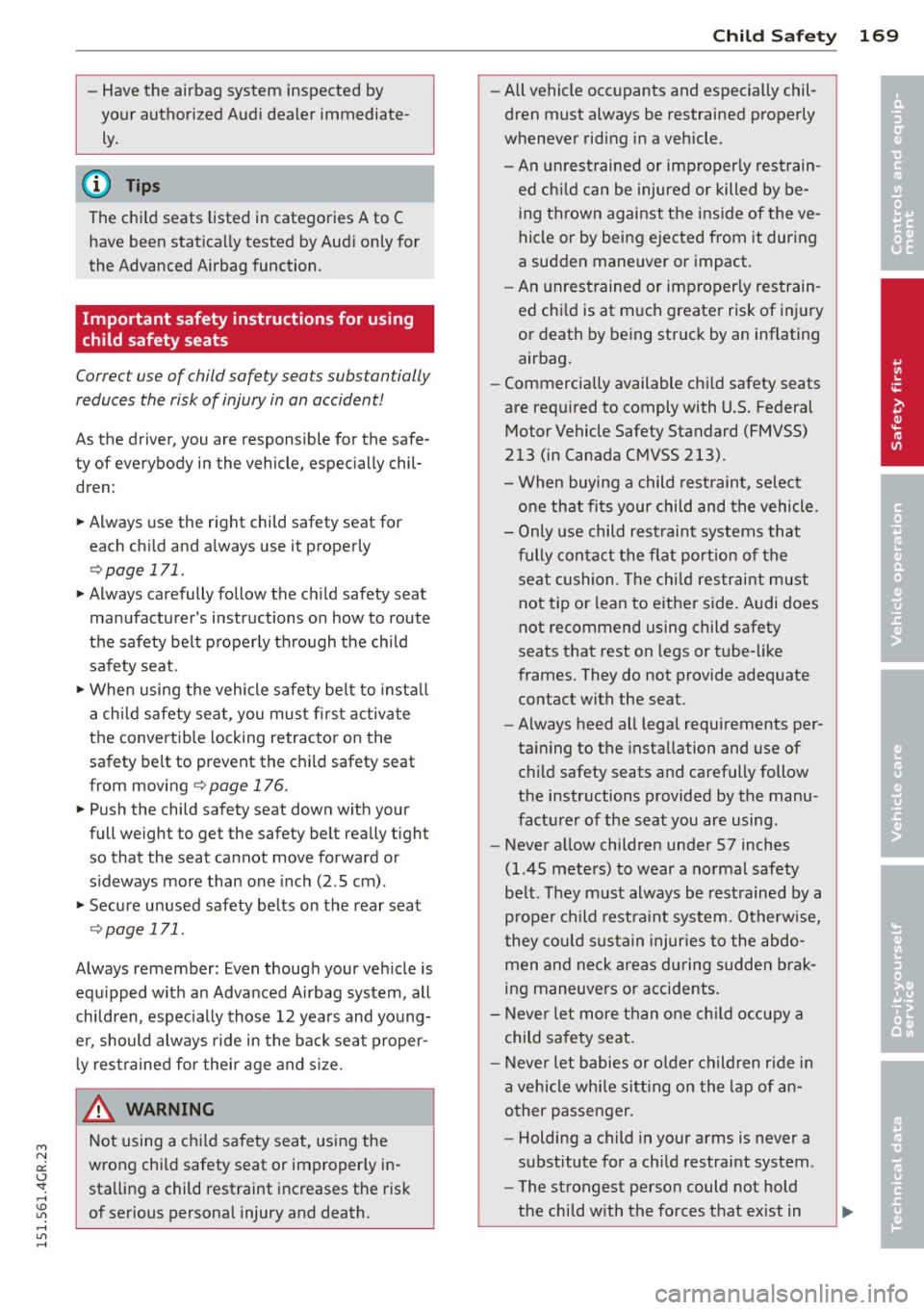
M N
0:: <.J 'SI: ,...., \!) 1.1"1 ,...., 1.1"1 ,....,
-Have the airbag system inspected by
your authorized Audi dealer immediate
ly.
(D Tips
The child seats listed in categories A to C have been statically tested by Audi only for
the Advanced Airbag function.
Important safety instructions for using
child safety seats
Correct use of child safety seats substantially
reduces the risk of injury in an accident!
As the driver, you are responsible for the safe
ty of everybody in the vehicle, especially chil
dren:
~ Always use the right child safety seat for
each child and always use it properly
¢ page 171.
~ Always carefully follow the child safety seat
manufacturer's instructions on how to route
the safety belt properly through the child
safety seat.
~ When using the vehicle safety belt to install
a child safety seat, you must first activate
the convertible locking retractor on the
safety belt to prevent the child safety seat
from moving
¢ page 176.
~ Push the child safety seat down with your
full weight to get the safety belt really tight so that the seat cannot move forward or
sideways more than one inch (2.5 cm) .
~ Secure unused safety belts on the rear seat
¢page 171.
Always remember: Even though your vehicle is
equipped with an Advanced Airbag system, all
children, especially those 12 years and young
er, should always ride in the back seat proper
ly restrained for their age and size.
_& WARNING
Not using a child safety seat, using the
wrong child safety seat or improperly in stalling a child restraint increases the risk
of serious personal injury and death.
-
Child Safety 169
- All vehicle occupants and especially chil
dren must always be restrained properly
whenever riding in a vehicle.
- An unrestrained or improperly restrain
ed child can be injured or killed by be
ing thrown against the inside of the ve
hicle or by being ejected from it during
a sudden maneuver or impact.
- An unrestrained or improperly restrain
ed child is at much greater risk of injury
or death by being struck by an inflating
airbag.
- Commercially available child safety seats
are required to comply with U.S. Federal
Motor Vehicle Safety Standard (FMVSS)
213 (in Canada CMVSS 213).
- When buying a child restraint, select
one that fits your child and the vehicle.
- Only use child restraint systems that
fully contact the flat portion of the
seat cushion. The child restraint must not tip or lean to either side. Audi does
not recommend using child safety
seats that rest on legs or tube •like
frames. They do not provide adequate
contact with the seat.
- Always heed all legal requirements per
taining to the installation and use of
child safety seats and carefully follow
the instructions provided by the manu
facturer of the seat you are using.
- Never allow children under 57 inches
(1.45 meters) to wear a normal safety
belt. They must always be restrained by a
proper child restraint system. Otherwise,
they could sustain injuries to the abdo
men and neck areas during sudden brak
ing maneuvers or accidents.
- Never let more than one child occupy a
child safety seat.
- Never let babies or older children ride in
a vehicle while sitting on the lap of an
other passenger.
- Holding a child in your arms is never a
substitute for a child restraint system .
- The strongest person could not hold
the child with the forces that exist in
•
•
Page 172 of 302
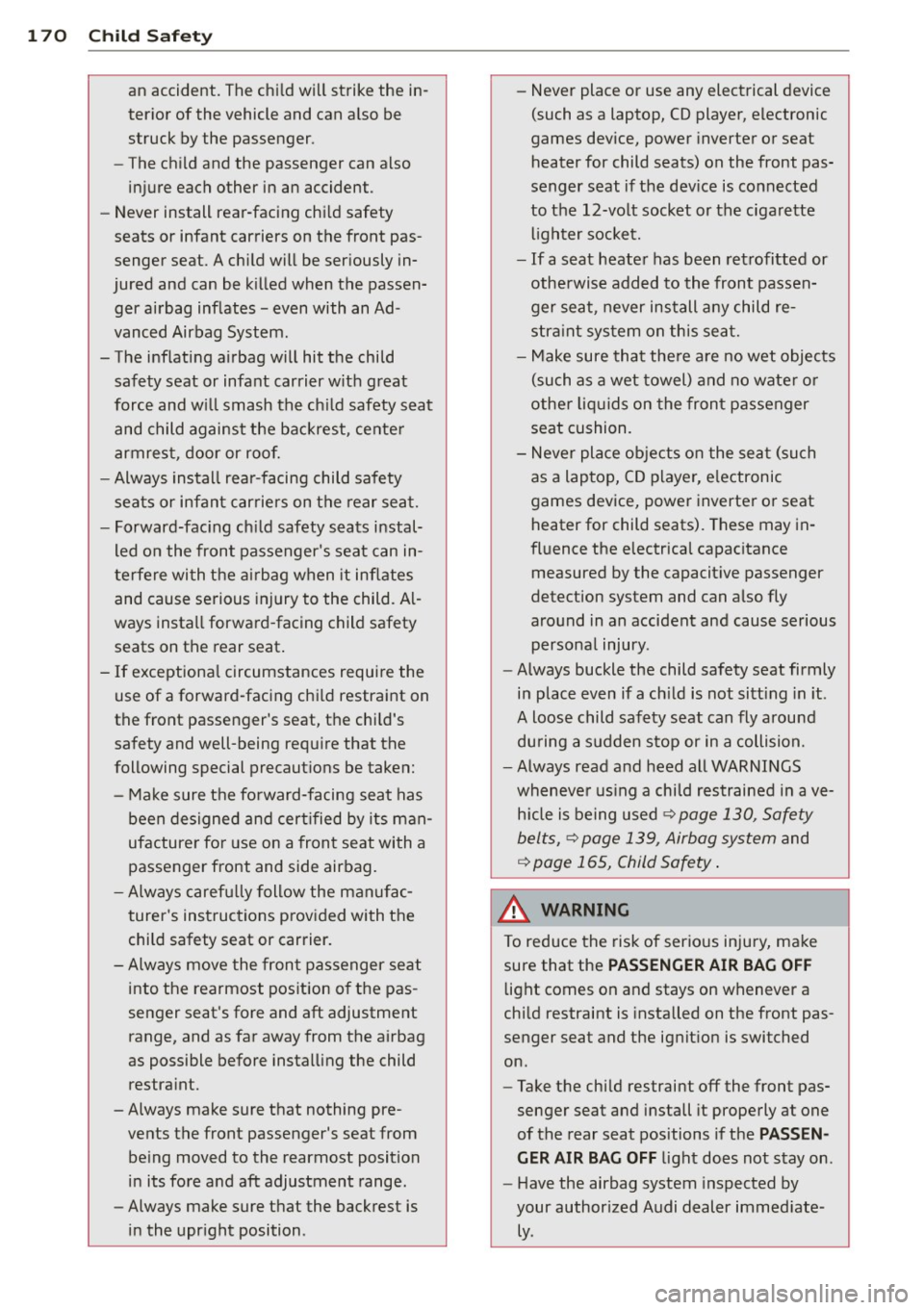
1 70 Child Safety
an accident. The child will strike the in
terior of the vehicle and can also be
struck by the passenger.
- The child and the passenger can also
injure each other in an accident .
- Never install rear-facing child safety
seats or infant carriers on the front pas
senger seat. A child will be seriously in
jured and can be killed when the passen ger airbag inflates - even with an Ad
vanced Airbag System.
- The inflating airbag will hit the child safety seat or infant carrier with great
force and will smash the child safety seat
and child against the backrest, center
armrest, door or roof.
- Always install rear-facing child safety
seats or infant carriers on the rear seat.
- Forward-facing child safety seats instal
led on the front passenger's seat can in
terfere with the airbag when it inflates
and cause serious injury to the child. Al
ways install forward-facing child safety
seats on the rear seat.
- If exceptional circumstances require the use of a forward-facing child restraint on
the front passenger's seat, the child's safety and well-being require that the
following special precautions be taken:
- Make sure the forward-facing seat has
been designed and certified by its man
ufacturer for use on a front seat with a
passenger front and side airbag.
- Always carefully follow the manufac
turer's instructions provided with the
child safety seat or carrier.
- Always move the front passenger seat
into the rearmost position of the pas
senger seat's fore and aft adjustment
range, and as far away from the airbag
as possible before installing the child
restraint.
- Always make sure that nothing pre
vents the front passenger 's seat from
being moved to the rearmost position
in its fore and aft adjustment range.
- Always make sure that the backrest is
in the upright position . -
Never place or use any electrical device
(such as a laptop, CO player, electronic
games device, power inverter or seat
heater for child seats) on the front pas
senger seat if the device is connected
to the 12-volt socket or the cigarette
lighter socket.
- If a seat heater has been retrofitted or
otherwise added to the front passen
ger seat , never install any child re
straint system on this seat.
- Make sure that there are no wet objects
(such as a wet towel) and no water or
other liquids on the front passenger
seat cushion.
- Never place objects on the seat (such
as a laptop, CO player, electronic
games device, power inverter or seat
heater for child seats) . These may in
fluence the electrical capacitance
measured by the capacitive passenger
detection system and can also fly
around in an accident and cause serious
personal injury .
- Always buckle the child safety seat firmly
in place even if a child is not sitting in it.
A loose child safety seat can fly around
during a sudden stop or in a collision.
-Always read and heed all WARNINGS
whenever using a child restrained in ave
hicle is being used
~page 130, Safety
belts,
~ page 139, Airbag system and
~ page 165, Child Safety.
A WARNING
To reduce the risk of serious injury, make
sure that the
PASSENGER AIR BAG OFF
light comes on and stays on whenever a
child restraint is installed on the front pas
senger seat and the ignition is switched
on.
- Take the child restraint off the front pas
senger seat and install it properly at one
of the rear seat positions if the
PASSEN
GER AIR BAG OFF
light does not stay on .
- Have the airbag system inspected by
your authorized Audi dealer immediate ly .
Page 173 of 302
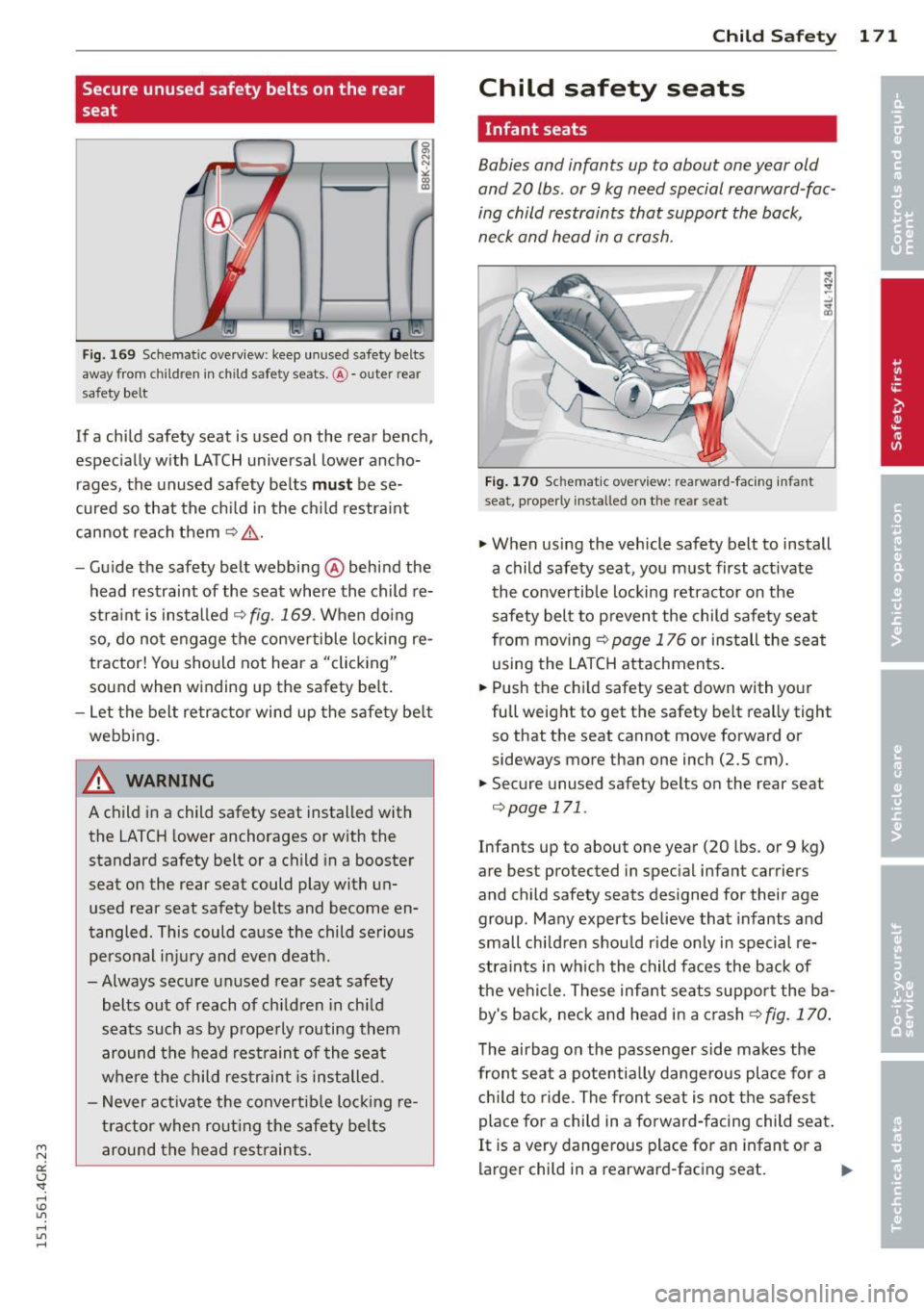
"' N
a:: I.J ""'. rl I.O
"' rl
"' rl
Secure unused safety belts on the rear
seat
F ig. 169 Schematic overview: keep unused safety belts
away from chi ldren in child safety seats. @-outer rear
safety belt
If a child safety seat is used o n the rear bench,
espec ially with LATCH universal lower ancho
rages, the unused safety belts
mu st be se
cured so that the ch ild in the ch ild restra int
cannot reach them ¢
,&..
- Gu ide the safety belt webbing @behind the
head restraint of the seat where the child re
stra int is ins ta ll ed
¢ fig. 169. When do ing
so, do not engage the conve rtible locking re
tractor! You should not hear a "clicking''
sound when winding up the safety be lt.
- Let the belt re tractor wind up the s afety be lt
webbing.
_& WARNING
A child in a child safety seat installed with
the LATCH lower anchorages or with the
standard safety belt or a child in a booster
seat on the rear seat could play with u n used rear seat safety belts and become en
tangled. This could cause the child serious
pe rsonal in ju ry and even deat h.
-Always secure u nused rear seat safety
belts out of reach of ch ild ren in ch ild
sea ts such as by properly routing them
around the head res traint of the sea t
whe re the child res traint is installed.
- Never act ivate the convertib le loc king re
tra ctor when rout ing the safety belts
around the head res traints.
Child S afety 1 71
Child safety seats
Infant seats
Babies and infants up to about one year old
and 20 lbs. or 9 kg need special rearward-fac
ing child restraints that support the back,
neck and head in a crash.
Fig . 170 Schematic overv iew: rearward-fac ing infant
seat, properly installed on t he rear seat
.. When using the vehicle safety belt to install
a child safety seat, you must first activate
the convertib le locki ng retractor on the
safety belt to p revent the child safety seat
from moving¢
page 176 or install the seat
using the LATCH attachmen ts .
.. Push the chi ld safety seat down with your
full weight to get the safety belt really tight
so that the seat cannot move forward or
sideways more than one inch (2.5 cm).
.. Secure unused safety belts on the rear seat
¢page 171.
Infants up to about one year (20 lbs. or 9 kg)
are best protected in spec ial infant carriers
and child safety seats designed for their age
group . Many experts believe that infants and
small ch ildren shou ld r ide on ly in special re
stra in ts in wh ich the child fa ces the back of
the vehi cle. These infant sea ts support the ba
by 's back, neck and head in a crash ¢
fig. 170 .
The airbag on the passenger side makes the
front seat a potentia lly dange rous place for a
ch ild to ride. The front seat is not the safest
place for a child in a fo rward-facing child seat.
It is a very dangerous place for an infant or a
larger child in a rearward-facing seat. .,._
Page 174 of 302
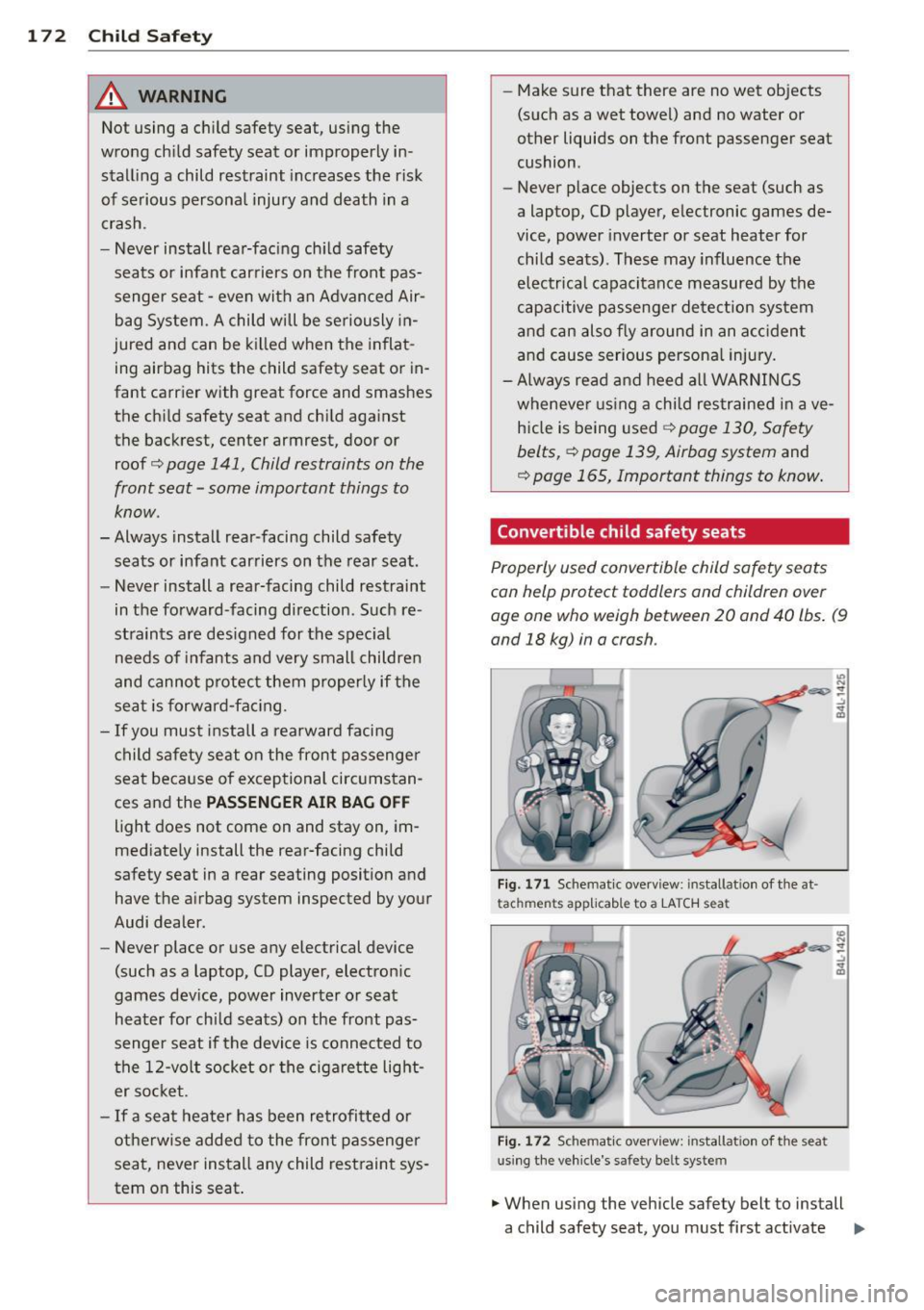
172 Child Safety
& WARNING
Not using a child safety seat, using the
wrong child safety seat or improperly in
stalling a child restraint increases the risk
of serious personal injury and death in a
crash .
- Never install rear-facing child safety
seats or infant carriers on the front pas
senger seat - even with an Advanced Air
bag System. A child will be seriously in
jured and can be killed when the inflat
ing airbag hits the child safety seat or in
fant carrier with great force and smashes
the child safety seat and child against
the backrest, center armrest, door or roof
c:> page 141, Child restraints on the
front seat -some important things to
know .
- Always install rear-facing child safety
seats or infant carriers on the rear seat.
- Never install a rear-facing child restraint
in the forward-facing direction . Such re
straints are designed for the special
needs of infants and very small children
and cannot protect them properly if the
seat is forward-facing .
- If you must install a rearward facing
child safety seat on the front passenger seat because of exceptional circumstan
ces and the
PASSENGER AIR BAG OFF
light does not come on and stay on, im
mediately install the rear-facing child
safety seat in a rear seating position and have the airbag system inspected by your
Audi dealer .
- Never place or use any electrical device
(such as a laptop, CD player, electronic
games device, power inverter or seat heater for child seats) on the front pas
senger seat if the device is connected to
the 12-volt socket or the cigarette light
er socket.
- If a seat heater has been retrofitted or
otherwise added to the front passenger
seat, never install any child restraint sys
tem on this seat. -
Make sure that there are no wet objects
(such as a wet towel) and no water or
other liquids on the front passenger seat
cushion .
- Never place objects on the seat (such as
a laptop, CD player, electronic games de
vice, power inverter or seat heater for
child seats). These may influence the
electrical capacitance measured by the
capacitive passenger detection system
and can also fly around in an accident
and cause serious personal injury.
- Always read and heed all WARNINGS
whenever using a child restrained in ave
hicle is being used
c:> page 130, Safety
belts,
c:> page 139 , Airbag system and
c:> page 165, Important things to know.
Convertible child safety seats
Properly used convertible child safety seats
can help protect toddlers and children over
age one who weigh between 20 and 40 lbs. (9
and 18 kg) in a crash .
Fig. 171 Schematic overview: installat ion of the at
ta chments applicab le to a LA TCH seat
Fig. 172 Schemat ic overview: installa tion of the seat
u sing the vehicle 's s afety belt syste m
.,. When using the vehicle safety belt to install
a child safety seat, you must first activate ..,.
Page 175 of 302
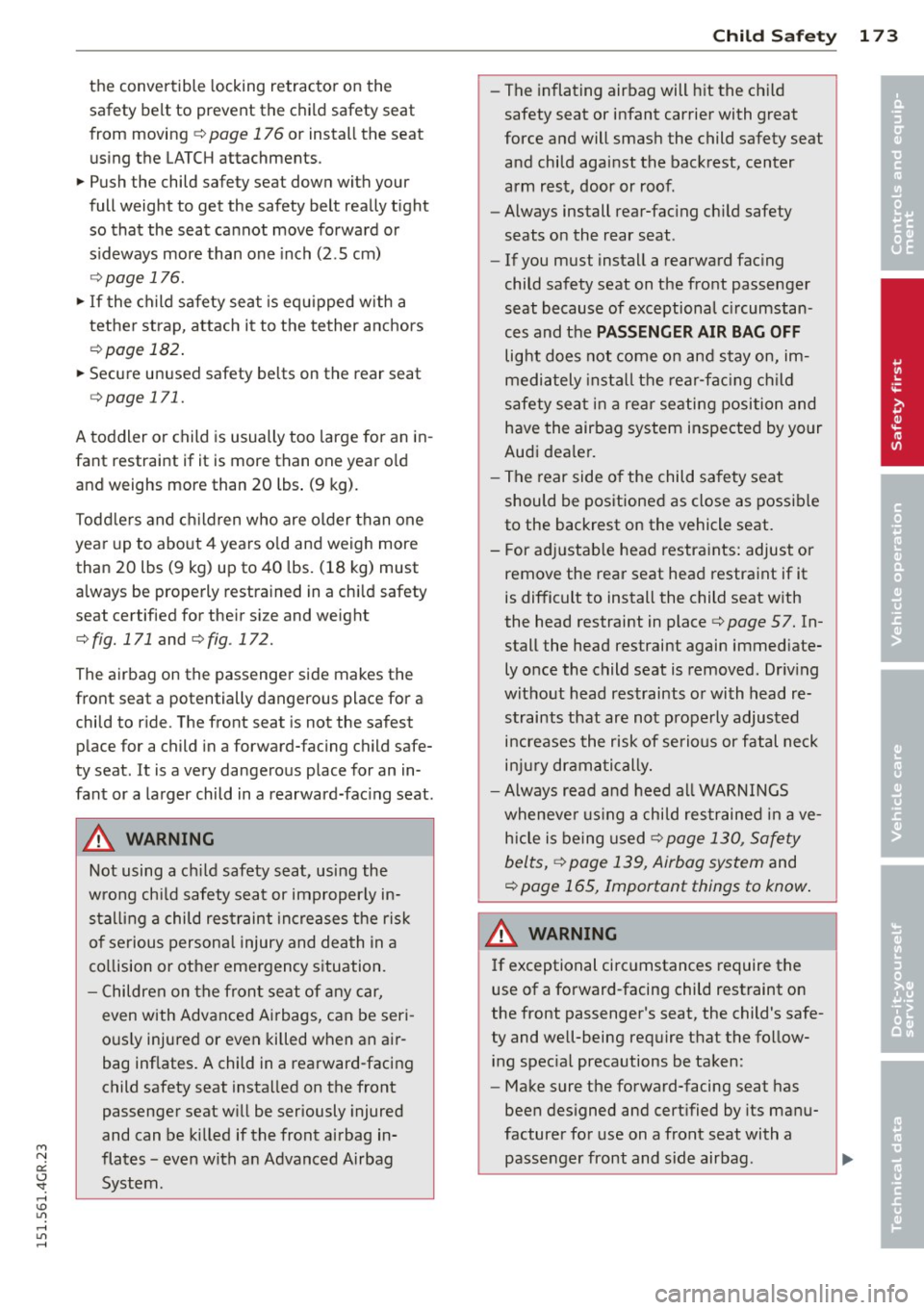
M N
0:: <.J 'SI: ,...., \!) 1.1"1 ,...., 1.1"1 ,....,
the convertibl e locking retractor on the
safety belt to prevent the child safety seat
from moving ¢
page 176 or install the seat
u sing the LATCH attachments .
.,. Push the child safe ty seat down with you r
full weight to get the safety belt really tight
so that the seat cannot move forward or sideways more than one inch (2.5 cm)
¢ page 176.
.,. If the child safety seat is equipped with a
tether strap, attach it to the tether anchors
¢page 182.
.,. Secure unused safety belts on the rear seat
Q page 171.
A toddler or child is usually too large for an in
fant restraint if it is more than one year old and weighs more than 20 lbs. (9 kg).
Toddlers and children who are older than one
year up to about 4 years old and weigh more
than 20 lbs (9 kg) up to 40 lbs. (18 kg) must
always be properly restrained in a child safety
seat certified for their size and weight
¢fig. 171 and Qfig . 172.
The airbag on the passenger side makes the
front seat a potentially dangerous place for a
child to ride. The front seat is not the safest
place for a child in a forward-facing child safe
ty seat. It is a very dangerous place for an in
fant or a larger child in a rearward-facing seat.
A WARNING
Not using a child safety seat , using the
wrong child safety seat or improperly in
stalling a child restraint increases the risk
of serious personal injury and death in a
collision or other emergency situation.
- Children on the front seat of any car,
even with Advanced Airbags, can be seri
ously injured or even killed when an air
bag inflates. A child in a rearward-facing
child safety seat installed on the front
passenger seat will be seriously injured
and can be killed if the front airbag in
flates - even with an Advanced Airbag
System.
Child Safety 173
- The inflating airbag will hit the child
safety seat or infant carrier with great
force and will smash the child safety seat and child against the backrest, center
arm rest, door or roof.
- Always install rear-facing child safety
seats on the rear seat.
- If you must install a rearward facing
child safety seat on the front passenger
seat because of exceptional circumstan
ces and the
PASSENGER AIR BAG OFF
light does not come on and stay on, im
mediately install the rear-facing child
safety seat in a rear seating position and have the airbag system inspected by your
Audi dealer.
- The rear side of the child safety seat
should be positioned as close as possible
to the backrest on the vehicle seat.
- For adjustable head restraints: adjust or
remove the rear seat head restraint if it
is difficult to install the child seat with
the head restraint in place¢
page 57. In
stall the head restraint again immediate
ly once the child seat is removed. Driving
without head restraints or with head re straints that are not properly adjusted increases the risk of serious or fatal neck
injury dramatically.
-Always read and heed all WARNINGS
whenever using a child restrained in ave
hicle is being used
¢page 130, Safety
belts,
Q page 139, Airbag system and
¢ page 165, Important things to know.
A WARNING
-
If exceptional circumstances require the
use of a forward-facing child restraint on
the front passenger's seat, the child's safe
ty and well-being require that the follow ing special precautions be taken:
- Make sure the forward-facing seat has
been designed and certified by its manu
facturer for use on a front seat with a passenger front and side airbag .
•
•
Page 176 of 302
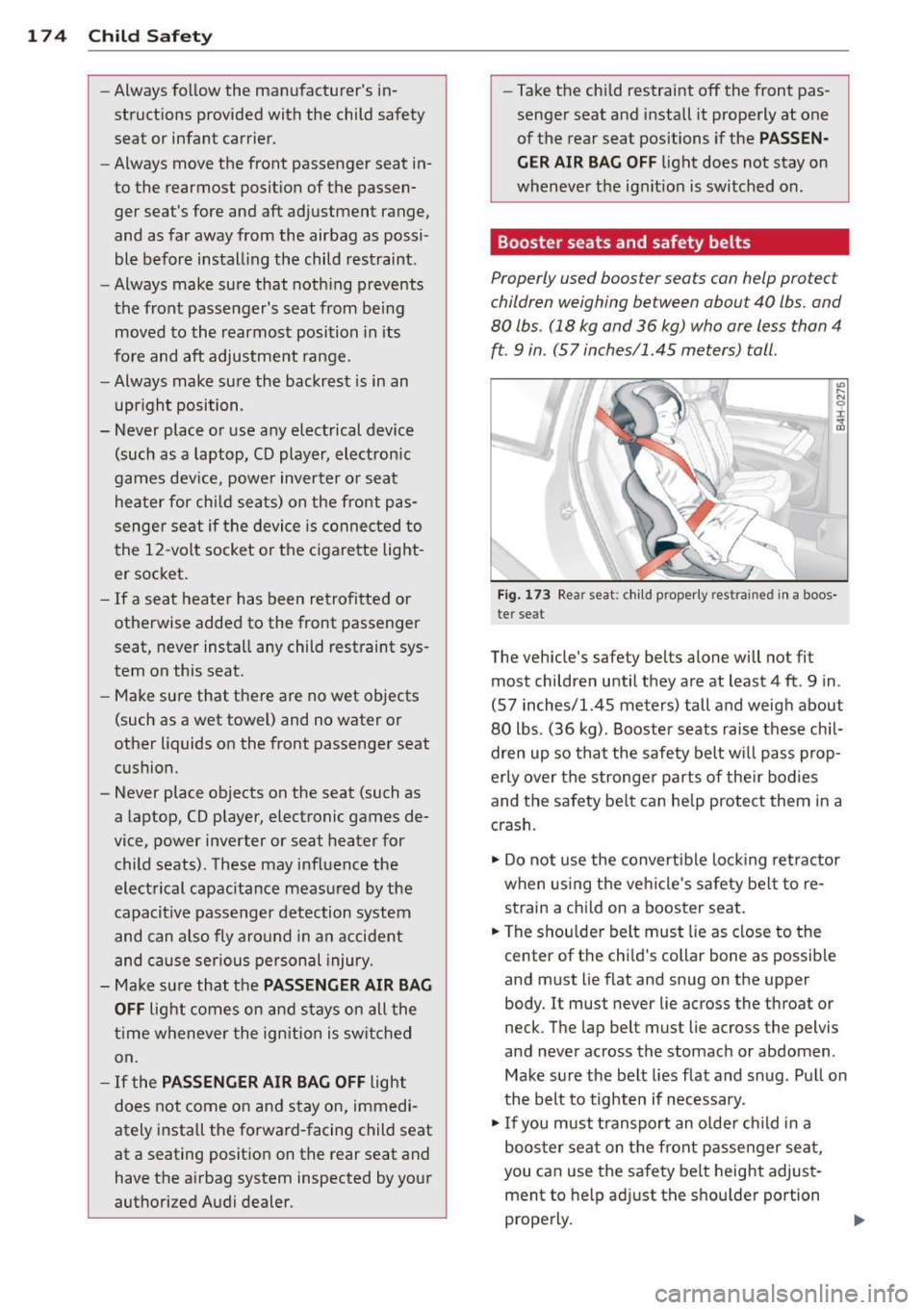
17 4 Child Safety
- Always follow the man ufacturer's in
structions provided with the child safety
seat or infant carrier.
- Always move the front passenger seat in
to the rearmost position of the passen
ger seat's fore and aft adjustment range,
and as far away from the airbag as possi
ble before install ing the child restraint .
- Always make sure that nothing prevents
the front passenger's seat from being
moved to the rearmost position in its
fore and aft adjustme nt range.
- Always make sure the backrest is in an
upright position.
- Never place or use any electrical device
(such as a laptop, CD player, electron ic
games device, power inverter or seat
heater for child seats) on the front pas
senger seat if the device is connected to
the 12-volt socket or the cigarette light
er socket.
- If a seat heater has been retrofitted or
otherwise added to the front passenger
seat, never install any child restraint sys
tem on this seat.
- Make sure that there are no wet objects
(such as a wet towel) and no water or
other liquids on the front passenger seat
cushion.
- Never place objects on the seat (such as
a laptop, CD player, electronic games de
vice, power inverter or seat heater for
child seats). These may influence the
electrical capacitance measured by the
capacitive passenger detection system
and can also fly around in an accident
and cause serious personal injury .
- Make sure that the
PASSENGER AIR BAG
OFF
light comes on and stays on all the
time whenever the ignition is switched
on.
- If the
PASSENGER AIR BAG OFF light
does not come on and stay on, immedi
ately install the forward-facing child seat
at a seating position on the rear seat and
have the airbag system inspected by your
authorized Audi dealer. -
Take the chi ld restraint off the front pas
senger seat and install it properly at one
of the rear seat positions if the
PASSEN
GER AIR BAG OFF
light does not stay on
whenever the ign it ion is switched on.
Booster seats and safety belts
Properly used booster seats can help protect
children weighing between about 40 lbs. and
80 lbs. (18 kg and 36 kg) who are less than 4
ft. 9 in . (57 inches/1 .45 meters) tall .
"' ....
"' 0 ±
o5
Fig. 173 Rear seat: c hild properly restrained in a boos
te r seat
The vehicle 's safety belts alone will not fit
most children until they are at least 4 ft . 9 in.
(57 inches/1.45 meters) tall and weigh about
80 lbs. (36 kg). Booster seats raise these ch il
dren up so that the safety belt w ill pass prop
er ly over the stronger parts of the ir bodies
and the safety be lt can he lp protect them in a
crash.
.,. Do not use the convertible locking retractor
when using the vehi cle's safety belt to re
strain a ch ild on a booster seat.
.. The shou lder belt must lie as close to the
center of the chi ld's collar bone as possib le
and must lie flat and snug on the upper
body. It must never lie across the throat or
neck . The lap belt must lie across the pelvis
and never across the stomach or abdomen .
Make s ure the belt lies flat and snug. Pull on
the belt to tighten if necessary .
.,. If you must transport an older child in a
booster seat on the front passenger seat,
you can use the safety be lt height adjust
ment to help adjust the s hou lder portion
properly. ..,.
Page 177 of 302

M N
0:: <.J 'SI: ,...., \!) 1.1'1 ,...., 1.1'1 ,....,
~ Secure unused safety belts on the rear seat
c::> page 171 .
Children up to at leas t 8 years old (over 40 lbs
or 18 kg) are best protected in chi ld safety
seats designed for their age and weight . Ex
perts say that the ske letal structure, particu
larly the pelvis, of these chi ldren is not fu lly
developed, and they must not use the vehicle
safety belts without a su itable child restraint.
It is usually best to put these children in ap
propriate booster seats. Be sure the booster
seat meets all applicable safety standards .
Booster seats raise the seating position of the
chi ld and reposition both the lap and shou lder
parts of the safety belt so that they pass
across the child 's body in the right places. The
routing of the belt over the child's body is very
important for the ch ild's protection, whether
or not a booste r seat is used . Children age 12
and under must always ride in the rear seat.
C hi ldren who are at least 4
ft. 9 in. (57 in
ches/1.45 meters) tall can generally use the
vehicle's three po int lap and shoulder belts .
Never use the lap belt portion of the veh icle's
safety be lt a lone to restrain any child, regard
l ess of how b ig the child is. Always remembe r
that children do not have the pronounced pe l
vic structure required for the proper function
of lap belt portion of the ve hicle's three point
l ap and shoulder be lts. The child's safety ab
solutely requ ires that a lap be lt portion of the
safety belt be fastened snugly and as low as
possible around the pelvis. Never let the lap
be lt portion of the safety belt pass over the
child's stomach or abdomen.
In a cras h, airbags must i nflate within a blink
of an eye and with cons iderable force. In orde r
to do i ts job, the airbag needs room to inflate
so that it will be there to p rotect the o ccupant
as the occupant moves forward into the air
bag.
A vehicle occupant who is out of pos ition and
too close to the airbag gets i n the way of an
inflat ing a irbag. When an occupant is too
close, he or she w ill be str uck violen tly and
Child Sa fet y 175
will receive se rious or possib ly even fatal in
jury .
In orde r fo r the airbag to offer pro te ction, i t is
important tha t all veh icle occupants, espec ial
ly any children, who m ust be in the front seat
because of exceptiona l circumstances, be
properly restrained and as far away from the
airbag as possible . By keeping room between
the child's body and the front of the passen
ger compartment, the a irbag can inflate com
pletely and provide supplemental protection
in certain frontal collisions .
_&. WARNING
Not using a booste r seat, using the boos
ter se at imp roperly, incorrectly installing a
boos ter sea t or using the vehicle safety
belt imp roperly increases the risk of seri
ous persona l injury and death in a collision
or other emergency situat ion. To he lp re
duce the risk of serious personal injury
and/or death:
- The shou lder belt must lie as close to the
center of the ch ild's collar bone as possi
ble and must lie f lat and snug on the up
per body . It must never lie across the
throat or neck . The lap belt must lie
across the pelvis and neve r across the
s tom ach o r abd omen. Make sure that the
be lt lies flat and sn ug. Pull on the bel t to
tighten if necessary.
- Failure to p roperly ro ute safety belts
over a child's body will ca use seve re inj u
ries in an accident or othe r emergency
situation
c::> page 130 .
-The rear side o f the child sa fety seat
should be pos itioned as close as possib le
to the backrest on the vehicle seat.
- For adj ustab le head restraints: adjust or
remove the rea r seat head restraint if it
is difficult to install the child seat w ith
the head restraint in place
c::> page 57. In
stall the head restraint again immed iate
ly once the child seat is removed. Dr iv ing
without head restraints o r with head re-
.
straints that are not properly adjusted ~
•
•
Page 178 of 302
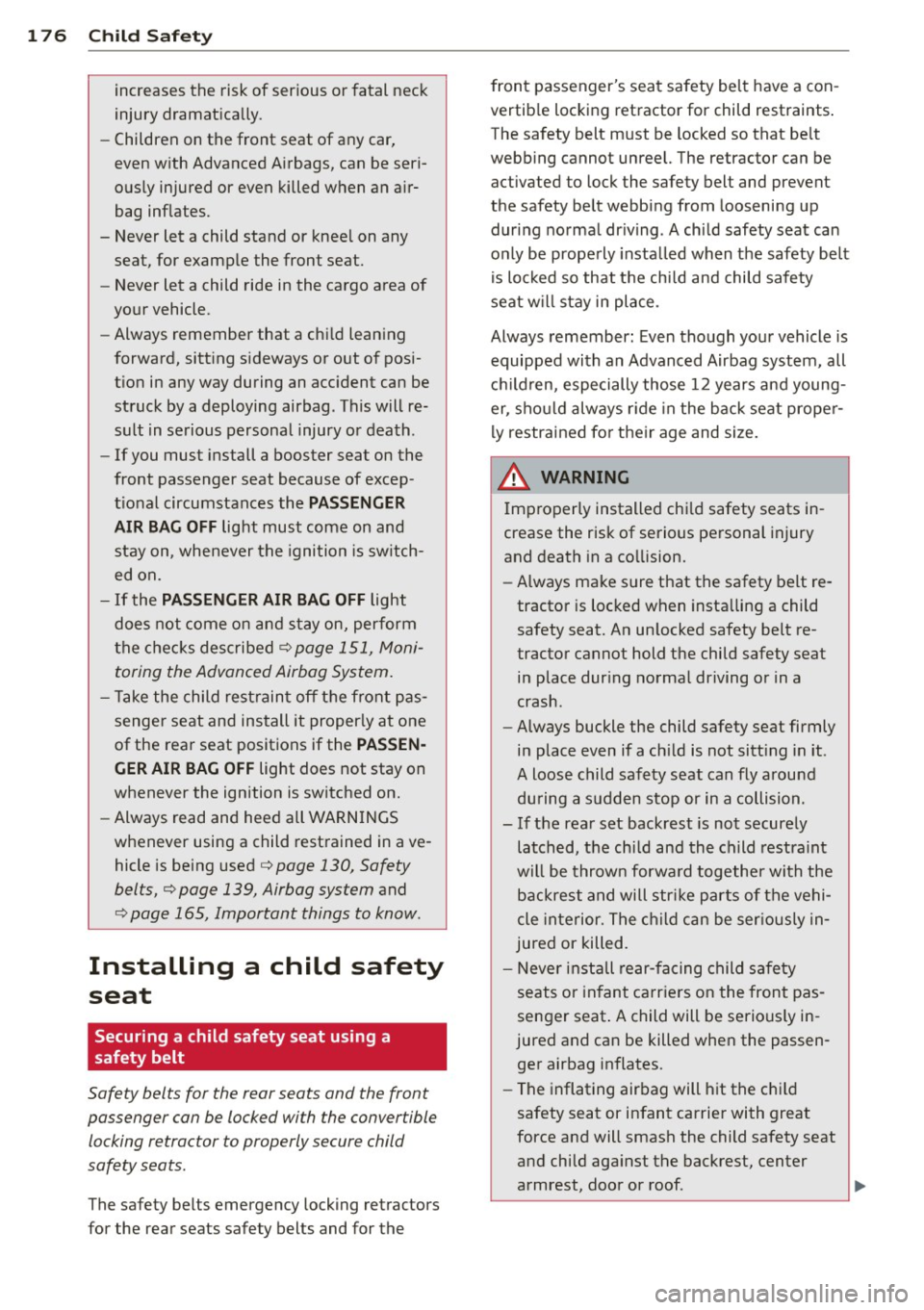
176 Child Saf ety
in creases the risk of serious or fatal neck
injury dramat ically.
- Children on the front seat of any car,
even w ith Advanced Airbags, can be seri
ous ly injured or even killed when an a ir
bag inf lates.
- Never let a child stand or knee l on any
seat, for example the front seat.
- Never let a child ride in the cargo area of
your vehicle.
- Always remember that a chi ld leaning
forward, sitt ing s ideways or out of posi
t ion in any way during an acc ident can be
struck by a deploying airbag . This will re
sult in serious personal injury or dea th .
- If you must install a booster seat on the
front passenger seat because of excep
t ional circumstances the
PASSENGER
AIR BAG OFF
light must come on and
stay on, whenever the igni tion is sw itch
ed on.
- If the
PASSENGER AIR BAG OFF light
does not come o n and s tay on, perform
the chec ks des cribed
<=> page 151, Moni
toring the Advanced Airbag System.
- T ake the child rest rain t off the front pas
senge r seat and install it proper ly at one
of the rea r seat positions if the
PASSEN
GER AIR BAG OFF
light does not stay on
whenever the ignition is switched on.
- Always read and hee d all WARNINGS
whenever using a child rest ra ined in ave
hicle is being used<=>
page 130, Safety
belts,<=> page 139, Airbag system
and
<=> page 165, Important things to know.
Installing a child safety
seat
Securing a child safety seat using a
safety belt
Safety belts for the rear seats and the front
passenger can be locked with the conver tible
locking retractor to properly secure child
safety seats.
The safety belts emergency locking retractors
f or the rear seats safe ty belts and for the fron
t passenger's seat safety be lt have a con
vertib le locking ret ractor for child restraints .
The safety belt m ust be locked so that be lt
webbing cannot unreel. The retractor can be activated to lock the safety belt and prevent
the safety belt webbing from looseni ng up
duri ng normal dr iv ing. A child safety seat can
o nl y be prope rly insta lled when the safety be lt
i s lo cked so that t he ch ild and child safety
sea t w ill stay in place .
Always remember : Even though your vehicle is
equipped with an Advanced Airbag system, all
c hi ld ren, especially those 1 2 years and young
er, sho uld always r ide in the back seat prope r
l y restra ined for the ir age and size.
& WARNING ,____._ -
I mproperly installed chi ld safety seats in
crease the risk of serious pe rsonal in jury
and death in a co llision.
- Always make s ure that the safety belt re
tracto r is locked when insta lling a child
safety seat. An un locked safety belt re
tractor cannot hold the child safety seat
in place dur ing no rma l driving o r in a
crash .
- Always buckle the child safety seat firmly
in place even if a ch ild is not sitt ing in it .
A loose child safety seat can fly arou nd
du ring a sudden stop or in a collision.
- If the rea r set backrest is not secure ly
latched, the ch ild and the child restra int
will be throw n forwa rd togethe r with the
backrest a nd wi ll str ike par ts of t he ve hi
cle interior. The chil d can be ser iously in
ju red or killed.
- N ever inst all re ar- fa cing child safety
seats or in fant c arriers on the front pas
sen ger seat . A child will be serious ly in
jured and can be killed whe n the passen
ge r airbag in flates.
- The inflating air bag will h it the c hild
safety seat or infant carrie r with great
force and will smash the child safety seat
and child aga inst t he backrest, center
armrest, door or roof.
Page 179 of 302

M N
0:: <.J 'SI: ,...., \!) 1.1'1 ,...., 1.1'1 ,....,
-Always install rear-facing child safety
seats or infant carriers on the rear seat.
- Forward-facing child safety seats or in
fant carriers installed on the front pas senger's seat may interfere with the de
ployment of the airbag and cause serious
injury to the child.
- It is safer to install a forward-facing
child safety seat on the rear seat .
- Always read and heed all WARNINGS
whenever using a child restrained in ave
hicle is being used
c;,page 165. Special
precautions apply when installing a child
safety seat on the front passenger seat
c:;, page 141, Child restraints on the front
seat -some important things to know.
_& WARNING
-
Always take special precautions if you
must install a forward or rearward-facing
child restraint on the front passenger's
seat in exceptional situations:
- Whenever a forward or rearward-facing
child restraint is installed on the front
passenger seat, the
PASSENGER AIR
BAG OFF
light must come on and stay on
whenever the ignition is switched on.
- If the PASSENGER AIR BAG OFF light
does not come on and stay on, perform
the checks described
c:;, page 151, Moni
toring the Advanced Airbag System .
-Take the child restraint off the front pas
senger seat and install it properly at one
of the rear seat positions if the
PASSEN
GER AIR BAG OFF
light does not stay on
whenever the ignition is switched on.
- Improper installation of child restraints
can reduce their effectiveness or even
prevent them from providing any protec
tion.
- An improperly installed child restraint
can interfere with the airbag as it de
ploys and seriously injure or even kill the
child.
- Always carefully follow the manufactur
er's instructions provided with the child
safety seat or carrier.
Child Safety 177
- After checking to make sure that the
child restraint is properly installed, make
certain that the child restraint is correct ly recognized by the capacitive passenger
detection system in the front passenger
seat and that the
PASSENGER AIR BAG
OFF
light signals the correct front pas
senger frontal airbag status .
_& WARNING
Forward-facing child restraints:
- Always make sure the forward-facing
seat has been designed and certified by
its manufacturer for use on a front seat
with a passenger front and side airbag.
- Never put the forward-facing child re
straint up, against or very near the in
strument panel.
- Always move the passenger seat into its
rearmost position in the seat's fore and
aft adjustment range, as far away from
the airbag as possible before installing
the forward-facing child restraint. The
backrest must be adjusted to an upright
position .
- Make sure that the
PASSENGER AIR BAG
OFF
light comes on and stays on all the
time whenever the ignition is switched
on.
_& WARNING
Rearward-facing child restraints:
- A child in a rearward-facing child safety
seat installed on the front passenger
seat will be seriously injured and can be killed if the front airbag inflates - even
with an Advanced Airbag System .
- The inflating airbag will hit the child
safety seat or infant carrier with great
force and will smash the child safety seat
and child against the backrest, center
armrest, door or roof.
-Always be especially careful if you must
install a rearward facing child safety seat
on the front passenger seat in exception-
al circumstances. ..,..
•
•
Page 180 of 302

178 Child Saf ety
- Make sure that the PASSENGER AIR BAG
OFF
light comes on and stays on all the
time whenever the ignition is switched on.
- If the
PASS ENGER AIR BAG OFF light
does not come on and stay on, immedi
ately install the rear-facing child safety
seat in a rear seating position and have
the a irbag system inspected by your Audi
dealer.
Activating the convertible locking retractor
Use the convertible locking retractor to se
cure a child restraint .
Always heed the child safety seat manufactur
e r's instructions when install ing a ch ild re
straint in your vehicle. To activate the conver
tib le locking retractor:
• Place the child restraint on a seat, prefera
bly on the rear seat.
• Slow ly pull the be lt
a ll th e wa y out.
• Route it around or through the chi ld re
straint be lt path
q ,& .
• Push the child safety seat down with your
full weight to get the safety belt rea lly t ight.
• Insert the belt tongue into the buckle for
that seating position.
• Gu ide the safety belt back into the retractor
unt il the belt lies flat a nd snug on the ch ild
safety seat.
> You should hear a "click ing" noise as t he
belt w inds back into the ine rtia reel. Test the
convertible locking retractor by pulling on
the belt . You should no longer be able to
pull the belt out of the retractor . The con
vertib le lock ing retractor is now act ivated.
• Make sure that the red release button is fac
ing away from the c hild restra int so that it
can be unbuckled quickly .
• Pullon the belt to make sure the safety belt
is p roperly t ight a nd fastened so that the
seat cannot move fo rward or sideways mo re
than one inch (2.5 cm).
A WARNING
Using the wrong child restraint or an im
p roperly installed chi ld restraint can cause
serious pe rsonal injury or death in a c rash .
- Always make sure that the safety belt re-
tractor is loc ked when installing a child
safety seat. An un locked safety belt re
tracto r cannot hold the child safety seat
in place dur ing no rma l driving o r in a
crash.
- Always buckle the child safety seat firmly
in place even if a ch ild is not si tt ing in it.
A loose child safety seat can fly around
during a s udden stop or in a crash .
- Always make sure the seat backrest to
which the child restraint is installed is in
an upright pos ition and securely latched
into place and cannot fold fo rward. Oth
erwise, the seatback with the child sa fety
seat attached to it could fly forward in
the event of an accident or other emer
gency situation.
- Always read and heed all WARNINGS
whenever us ing a child restrained in ave
h icle is being used
q page 165. Special
p recautions apply when insta lling a child
safety seat on the front passenger seat
q page 141, Child restraints on the front
seat -some important things to know.
-
Deactivating the convertible locking
retractor
The convertible locking retractor for child re
straints will be deactivated automatically when the belt is wound oil the way bock into
the retractor.
• Press the red b utton on the safety belt buck
le. The belt tong ue will pop o ut of t he b uck
le .
• Guide the safety belt all the way back into
its stowed position .
Always let the safety be lt retract completely
into its stowed position. The safety be lt can
now be used as an ordinary safety belt w ith
out the convertible locking retracto r for child
rest raints .
...